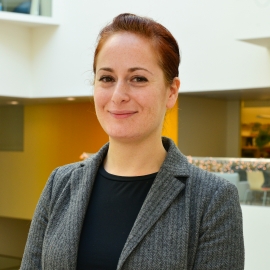
Ola Ozernov-Palchik, Ph.D., is a postdoctoral associate at the McGovern Institute for Brain Research at the Massachusetts Institute of Technology (MIT), studying reading development and dyslexia. Ola applies neurocognitive methods to investigating individual differences in dyslexia in emerging readers. She is interested in the interplay between children and their environment in shaping the development of reading skills. The reciprocity between research and real-world practices is an important goal of her work.
When did you first become interested in dyslexia and literacy?
I was a voracious reader as a child and through books I came to appreciate the richness of human thought and the human experience. Books allowed me to transcend worlds beyond my own as a young child in the Soviet Union. During my family’s immigration to Israel, when I was nine, we lost a box with all of my childhood books. I quickly learned Hebrew, just so that I could continue reading. During my undergraduate studies, my love of reading and interest in research led me to a research assistant position in a reading research institute. After graduating I accepted a Research Associate position at the same institute working on large-scale research projects aimed at evaluating the efficacy of reading curricula developed by the institute’s researchers, and at developing and validating reading assessments. Through this work, I became interested in the underlying brain mechanisms of the processes we aimed to measure and remediate. Specifically, I was intrigued by the variability with which children, whose reading progress I monitored on a monthly basis, were responding to our interventions.
In parallel to my research position, I received a master’s in counseling degree and conducted individual and family therapy with children at a community counseling center. Through working in diverse schools and with families, I became acutely aware of the role that environmental context plays in children’s development. Following my interests, I took on the role of research coordinator in a developmental cognitive neuroscience laboratory on a project investigating the neuroimaging predictors of dyslexia in pre-reading children. I have continued to pursue this work during my doctoral studies and in my current position. Therefore, individual variability in dyslexia became apparent to me early in my academic career and I dedicated much of my pre-doctoral and doctoral work to uncovering the cognitive, neural, and environmental contributors to these differences.
What impact do you hope your research will have on early childhood reading outcomes?
I hope that through my work and the work of many others, we will be able to identify robust characteristics of students that will not make reading gains as expected in response to regular reading instruction in early grades and in response to reading intervention in later grades. Identifying which children will struggle with reading development, prior to reading instruction, will ameliorate the educational and psychosocial consequences of reading failure. There is a substantial variation in children’s response to intervention and I hope that our research will help inform individualization of instruction at the onset rather than on a trial-and-error basis.
How can we ensure that research is being applied to real-world practice?
I think the key is open and clear communication. There has been a movement in academia towards greater openness in research practices and communication of results. We as researchers should make sure that our findings are accessible to everyone. But it is also important that graduate programs train educators to be critical and informed consumers of research. Most of our research is in collaboration with schools and families. It has always been our goal as researchers for these collaborations to be two-sided. For example, we offered professional development seminars to teachers, workshops for parents, and brain awareness days to students in all schools who we have worked with.
Who has had the biggest impact on your work?
I am fortunate to have had amazing mentors throughout my career. Dr. Nadine Gaab at Children’s Hospital has shaped my thinking around the importance of identifying dyslexia prior to reading failure and the potential of neuroimaging methods to advance this goal. Dr. Maryanne Wolf, my doctoral advisor at Tufts University, was one of the first to propose multiple profiles of dyslexia and has impressed on me the heterogenous nature of dyslexia. Dr. John Gabrieli’s work at MIT has been a continuous inspiration to me by applying rigorous cognitive neuroscience methods to clinically and educationally significant problems. More recently, Dr. Tiffany Hogan at MGH has opened my eyes to the contribution of higher-level language skills to dyslexia.
What is your favorite thing about working at MIT?
MIT provides an intellectually rich and stimulating environment. I am constantly surrounded by brilliant, creative, and curious people. There is an incredible amount of collaboration and cross-pollination within MIT and with partner institutions. As a postdoctoral fellow, I have an incredible amount of support and access to invaluable resources.